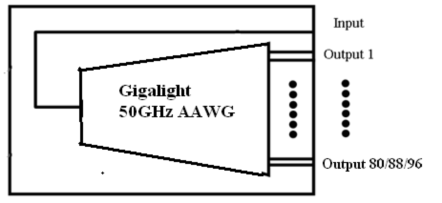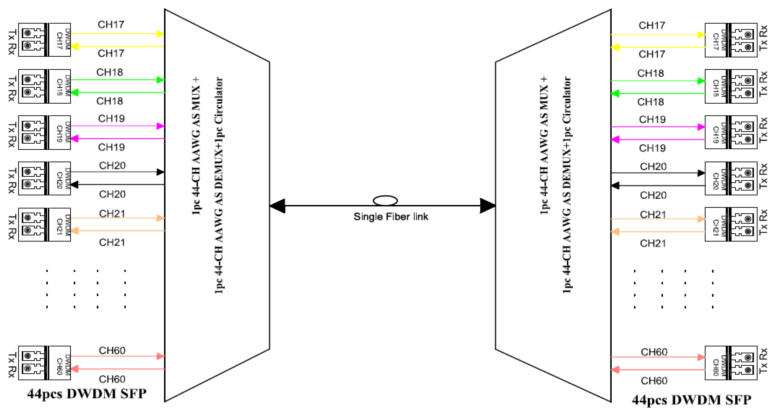Date:2019-04-26 Author:
offers a flexible DWDM solution with tunable transceivers and AAWG MUX/DEMUX modules.
To devise a more precise solution for the case, it is necessary to detailedly know what demerits of DWDM lasers are in advance. Therefore, CloudOptics will briefly analyse them first before getting involved in our solution.
As we know, weaknesses of DWDM lasers refers to these aspects. For one thing, with the development of technology, the amount of wavelength in DWDM 50GHz has reached the hundreds. Meanwhile, in the occasion that protection needs to be provided, the backup of each laser must be provided by the laser with substitutable wavelengths, which causes the increase in the quantity of backup DWDM optical module and in operating cost. For another thing, the quantity of stock in specific channels is difficult to predict on account that the wavelength of common DWDM optical module is fixed, which result in the increase in stock quantity of DWDM optical module with fixed wavelength. In addition, if the dynamic wavelength allocations in optical networks need to be supported and network flexibility needs to be improved, large number of common DWDM optical modules with different wavelengths are in demand. However, the usage rate of each optical module is very low, to some degree, this will bring about a waste of resources.
After realizing where the problems exist, CloudOptics developed tunable transceivers as the solution. In the solution, different DWDM wavelengths can be configured and output in the same optical module. These wavelength values and intervals meet the requirements of ITU-T (DWDM 50GHz full C-band). The wavelength-tunable optical module is with flexibility in selecting operating wavelength, which is with very large practical value in DWDM system, OADM and optical cross-connection, optical switching equipment, light source spare parts and so on.

In addition, the tunable transceiver adopts the chips with built-in integrated laser and MZ modulator, meets the ITU-T (50GHz DWDM ITU-T Full C-band) requirements and is with a tunable range of 90 channels based on 50GHz channel spacing. It will provide equipment manufacturers and operators with great flexibility, achieve the optimization for the overall network performance and greatly reduce the demand of existing operators for DWDM SFP + module inventory.
CloudOptics has launched 10G tunable SFP+ and 10G tunable XFP optical transceivers. The 10G tunable SFP+ is with low power consumption, lower than 1.7W. The wavelength of this module is stable and the transmit optical power is about 0dBm. The extinction ratio is greater than 10dBm; the side die suppression ratio is greater than 51dB, the eye-diagram crossing point is between 47% and 52 %, and the sensitivity of this module can reach above -24dBm. It supports distance up to 80km. And the 10G tunable XFP can be pided into two versions to support FEC coding function (OTN G.709 framing) and non-FEC coding function. The power consumption of the former is less than 4.5W, and the advantage of the FEC coding function is to improve the sensitivity of transmission; while the power consumption of the latter without FEC function is less than 3.5W. The two versions are available to meet maximum distance of 80km as well as to be compatible with the switches and core routers of Cisco, Juniper and other major equipment suppliers.
CloudOptics has also developed 50GHz AAWG DWDM MUX/DEMUX within 1U chassis package (able to be installed in a 19-inch rack) as the solution based on single-chip. This equipment is passive, without the need of power supply, and with 80/88/96 channel configuration optional; meanwhile, DWDM upgraded port and monitor port can be customized. Compared with inter-leaver plan, it has the advantages of low insertion loss and low cost.

The following diagram is a combination scheme of the CloudOptics flexible DWDM solution for long-haul optical transmission systems for reference.

 Copyright © 2019 cloudoptics. All Rights Reserved - Privacy Policy
Copyright © 2019 cloudoptics. All Rights Reserved - Privacy PolicyEmail: sales@cloudoptics.net